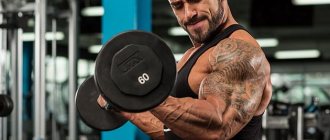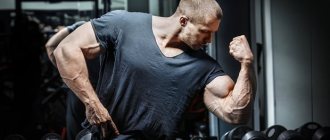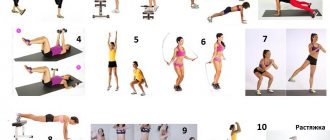Authors:
, And . May 13, 2021
Is periodizing a strength training program necessary for your clients?
Much of the literature on periodization to date has focused on increasing strength and improving athletic performance in athletes seeking to balance the demands of general fitness, specific fitness, and competition (Bartholomew, 2014). But many non-athlete clients also seek to accelerate muscle growth, and few studies address the question of whether the periodization model should be used in hypertrophy-focused strength training programs for non-athletes. This article reviews the best research to help answer the important question: Will periodizing a strength training plan help maximize skeletal muscle hypertrophy?
Some terms
Strength training programs consist of numerous variables including volume, intensity, frequency, rest intervals, exercise selection, and order (Williams et al., 2017). Periodization is the planned, cyclical (i.e. the program is repeated) manipulation of these strength training variables to achieve maximum results at specific times of the year (Evans, 2019). Periodic strength training plans consist of several cycles:
- macrocycle (6-12 months);
- mesocycles (~ 1 month);
- microcycles (~ 1 week) (Evans, 2019; Issurin, 2010).
The length of each training cycle will vary across sports depending on the competition schedule and the athlete's goals. Evans cites research noting that long periods of training without variation will lead to stagnation and fatigue. Thus, the primary goal of periodization is to provide structured variability to combat plateaus or declines in physical performance.
Types of periodization
Research focuses primarily on the three types of periodization most commonly used: linear, block, and wave.
Linear periodization
Linear periodization (LP)
is a training strategy that starts with high volume and low intensity and then progresses to low volume and high intensity (Grick et al., 2017). LP was introduced in the late 1950s by Russian professor Lev Matveev and is also called traditional periodization in the literature (Kok, Hamer, and Bishop, 2009; Bartolomei et al., 2014). With linear periodization, athletes gradually increase intensity as the program progresses while decreasing volume (see Figure 1).
Theoretically, the initial high-volume phase emphasizes hypertrophic adaptations, and the subsequent high-intensity period challenges the body's neural mechanisms (Kock, Hamer, & Bishop, 2009). In Fig. Figure 1 shows how in the LP model, in parallel with intensity, the specificity of training methods increases. Of course, each trainer will have their own LP training program, but the general rule is to change the volume and intensity every 4 weeks (Grick et al., 2017).
Rice. 1. Linear (traditional) periodization model.
Please note that as intensity increases, exercise volume decreases. In parallel with intensity, the specificity of training methods increases.
Source: Turner, 2011.
Block periodization
Block periodization (BP)
consists of several mesocycles with a concentrated effect on a specific indicator (Bartolomei et al., 2014) (Fig. 2). Each mesocycle, or block of time, prepares the client for the next cycle. For athletes, mesocycles are divided into three categories: accumulation, transformation and implementation (Issurin, 2010). The BP methodology was introduced in the mid-1980s by Russian scientist Yuri Verkhoshansky to meet the changing needs of athletes (Bartolomei et al., 2014).
Battery pack
focuses primarily on general aerobic endurance, core muscle strength, and fundamental movement techniques (Issurin 2010).
During the transformation block,
the athlete performs specialized exercises for muscular endurance and practices techniques specific to his sport (Issurin, 2010).
Finally, the implementation block
is the stage of preparation for competitions, focused on achieving maximum speed and performance. Each block lasts 2–4 weeks, depending on the length of the program and the client's specific goals (Issurin, 2010).
Rice. 2. Block periodization model. Repetitions - repetitions. Accumulation - accumulation. Transformation - transformation. Transition week - transition week. Realization - implementation. Weeks - weeks.
This is a model of block periodization of training to improve general fitness with 4-week blocks (compiled by the authors of this article). The goal of this program is to increase strength and muscle mass by progressively increasing training intensity (and decreasing volume) every 4 weeks. Please note that weeks 5, 10 and 15 are transition weeks of light intensity exercise. Approaches, choice and order of exercises, rest between approaches will be different for each client.
Wave-like periodization
Wave-like periodization (WP)
involves frequent changes in volume and intensity within a training program; these changes often occur weekly (WUP) and/or daily undulating periodization (DUP) (Evans, 2019) (Figures 3 and 4 with daily and weekly undulating periodization patterns). During the WUP program, you cycle through light, medium, and high-intensity workouts for weeks. During the DUP program, the intensity varies daily. Essentially, this means that in the DUP program, a client can perform both hypertrophy, strength, and power training in one week.
Evans summarizes research indicating that VP programs are best suited for strength development in strength training programs. McNamara and Stern (2010) state that the benefit of an undulating program is that it helps prevent boredom and overtraining. It is also easy to adapt to the client's travel schedule. Frequent changes in volume and intensity in EP programs can induce greater neural adaptations while preventing the development of fatigue (Pelzer, Ulrich, & Pfeiffer, 2017). If you graph the intensity, it will have a wave-like shape.
Rice. 3. Wave-like model of periodization by week. REPETITTIONS - repetitions. TRANSITION WEEK - transition week.
Please note that weeks 5 and 10 are transitional weeks. The intensity in this example is based on the percentage of the client's 1 rep max (1-RM).
Adapted from Bartholomew et al., 2015.
Rice. 4. Wave-like model of periodization by day. TO FATIGUE - to failure.
This program is based on intensity to failure in the rep range, where participants perform all exercises to muscle failure in each rep range (2-4, 8-12, 20-30). This pattern continues in subsequent weeks of training.
Adapted from Scheunfeld et al., 2021.
Periodization of training
Just recently there was no such concept at all. Bodybuilders have always trained hard and did not even think that alternating the nature of the loads could give them greater progress.
Periodization of training is a stepwise cycling of the focus, intensity and volume of training to achieve maximum strength and mass.
I think it’s clear that in order to develop maximum muscle growth at a certain stage (after 1-1.5 years of training) you need to train ALL MUSCLE STRUCTURES.
Those. there should be an increase (hypertrophy) of both myofibrils and sarcoplasm. The whole is always greater than the part.
For this purpose, periodization of loads using training cycles is used.
Let's understand a little about training cycles.
Exist:
- Macrocycle.
- Mesocycle.
- Microcycle.
A MACRO CYCLE, as a rule, in bodybuilding consists of three phases:
- Strength training (2-4 weeks).
- Hypertrophy , “working for mass” (8-12 weeks).
- Drying (8-10 weeks).
Each of these phases is called a MESO CYCLE (strength, mass gain, drying) and lasts differently. The weeks that make up mesocycles are divided into MICROCYCLES.
This macrocycle is “classical” due to its consistent change in volume and intensity of each phase. Those. as it moves from the power mesocycle to drying.
The main thing in bodybuilding is MUSCLE MASS AND BODY AESTHETICS. Strength plays an auxiliary function. That is why the classical macrocycle is built as I showed above.
It begins with the strength training mesocycle (2-4 weeks), then comes the longest and most important mesocycle of muscle gain (8-12 weeks), and then comes the cutting mesocycle, during which we try to burn as much fat as possible and maintain as much fat as possible. as many muscles as possible.
This is the so-called LINEAR PERIODIZATION of training. It is quite good, but its disadvantage is that we develop only ONE biomechanical quality to the detriment of another quality.
Those. During the strength mesocycle we lose endurance, and during high volume training we begin to lose strength. To all this we must add that during any linear mesocycle we can train only one type of muscle fiber. Here's a cool article about the different types of muscle fibers.
It is precisely because of these shortcomings that it will be very preferable to use MICROPERIODIZATION within a weekly microcycle.
The Unique Benefits of Periodized Strength Training
- Lifting weights in one intensity zone over time can cause performance to stagnate (Turner, 2011). A periodic program prevents stagnation by constantly overloading the neuromuscular system with varying intensities.
- Continuous training with heavy loads can lead to excessive fatigue, overtraining, and soft tissue injuries (Turner, 2011; Williams et al., 2017). Intermittent plans involve undulating periods of low, moderate and high volume and intensity to prevent overtraining and deterioration in performance.
- In accordance with the SAID principle (specific adaptations to imposed demands), periodic plans allow personal trainers and their clients to create a program to achieve a variety of specific training results.
- A brand new study shows that low-intensity strength training (30% of 1-RM) improves mitochondrial quality and quantity (i.e., ATP production of cell organelles) (Lim et al., 2019). Thus, intentionally incorporating low-intensity blocks will also improve the aerobic capacity of skeletal muscle fibers.
- Periodization allows trainers to easily incorporate taper weeks into a training program to promote recovery and promote neuromuscular adaptations (Turner, 2011).
- Periodization allows personal trainers to schedule push-out phases (short microcycles of increasing volume and/or intensity that provide a powerful stimulus for adaptation).
What is load periodization?
The term “periodization” appeared in bodybuilding quite recently. Until this time, the only correct solution was stable, intense training at maximum capacity. The exercises changed, but the load remained consistently high with a gradual increase. However, recent studies have proven that there is no point in fully loading your muscles every workout. This is how periodization of loads appeared, the meaning of which is to alternate light and heavy training.
This process involves cycling training direction, intensity and volume to achieve better results with less risk of mental and physical exhaustion. If you simplify the scheme as much as possible, you get an alternation of hard and light workouts. At the same time, there is less fatigue, more energy, and progress in gaining muscle mass is more stable.
Periodization and hypertrophy: main research results
Table 1. Increase in thickness of vastus lateralis and rectus femoris
| Muscle | Traditional periodization | Wave-like periodization by day |
| proximal VL | 19% | 14% |
| average VL | 18% | 17% |
| distal VL | 21% | 19% |
| RF | 16% | 11% |
The researchers measured the vastus lateralis using ultrasound at 33% (proximal VL), 50% (middle VL) and 66% (distal VL) of the femoral length, defined as the distance from the greater trochanter to the knee joint space. They performed an ultrasound examination of the rectus femoris approximately halfway between the anterior superior iliac spine and the proximal superior border of the patella.
Source: Peltzer, Ulrich and Pfeiffer, 2021.
Table 2. Ultrasound findings show that muscle size increases with Daily Undulating Periodization (DUP) compared to Constant Load (CSLD)
| Side to be measured | DUP % increase | CSLD % increase |
| vastus laterals | +7,6% | +8,6% |
| biceps | +6,6% | +5,0% |
| triceps | +6,4% | +4,2% |
Source: Scheunfeld et al., 2021.
Two studies in the past few years have focused on muscle hypertrophy as a result of periodization. One study focused on women doing moderate strength training and the other on men doing heavy strength training.
Here are reviews of these two works.
Women's moderate strength training
Pelzer, Ulrich, and Pfeiffer (2017) conducted a very interesting study with 19 college women, none of whom were professional athletes. The girls had been doing strength training for some time before (on average about 28 months). Participants were randomly assigned to one of two conditions on each leg: daily undulating periodization or traditional periodization (i.e. linear, as you remember). The participants controlled themselves, training one leg under one periodization, the other under the other. All participants trained 3 days a week for 6 weeks, for a total of 18 sessions and only one exercise - leg extension.
For the DUP leg, the intensity of 40%, 60% and 80% of 1-RM alternated daily, and for the TP leg, the exercise was performed at the same intensity for 2 weeks, starting at 40%, then the intensity steadily increased to 60%, and then up to 80% of 1-RM. Range of motion, volume, and time under tension were identical for both legs. Participants completed all sets with one leg before moving on to the other leg. There was a 2.5 minute rest between sets.
Ultrasound measurements showed that both groups significantly increased the thickness of the vastus lateralis and rectus femoris (see Table 1). There was no statistically significant difference in muscle thickness between groups (although it was slightly greater with TP).
Based on this research, when personal trainers are pressed for time and the client is looking for quick results (e.g., 4-6 weeks), DUP and TP are appropriate for creating a strong hypertrophic stimulus in women doing moderate strength training.
Men doing heavy weight training
Schoenfeld and colleagues (2016) divided young men involved in high-load strength training into two groups based on the weight they squatted with: a constant-load (CSLD) group (n = 9) and a wave-period daily group (n = 10). The CSLD group performed moderate-intensity strength training (8-12 repetitions), while the DUP group performed heavy (2-4 repetitions), moderate (8-12 repetitions), and light (20-30 repetitions) strength exercises on training days.
Both groups trained 3 days a week for 8 weeks. All participants performed each set of the exercise to failure, defined as the inability to complete the concentric phase of the movement. The rest between sets was 2 minutes. Seven full-body exercises were performed each day: bench press, military press, lat pull-down, seated horizontal row, barbell squat, and leg extension. Biceps, triceps, and vastus lateralis thicknesses were measured using ultrasound at baseline and after 8 weeks of resistance training (see Table 2).
Both groups significantly increased muscle thickness, and there was no statistical difference in results between the two protocols. When examining the statistical magnitude of change from pretest to posttest, called effect size,
The researchers found that DUP produced greater improvements than CSLD in the biceps and triceps. This suggests that the higher performance in the DUP group for the triceps and biceps is noteworthy. In summary, the study results indicate that 8 weeks of DUP or CSLD training can significantly improve muscle adaptation in training men.
What is muscle hypertrophy and what does it depend on?
If you want to build muscle, then you need to stick to a clear plan. To make this task easier, you should establish a specific daily routine for yourself, including exercise, nutrition, rest and sleep. Unfortunately, choosing a few exercises and diets and sticking with them is not enough. Many people start doing the same exercises for the same muscle groups while sticking to the same diet - but this does not help them achieve their goal, because they have not understood the importance of a systematic approach to bodybuilding. And they stuck to the same training system for months or years, without creating the necessary level of stress for the muscles, or, on the contrary, they changed the scheme very often, which also did not give results.
If you enter the gym, look for already familiar exercise equipment with your eyes and start doing strength training according to the same plan, then even after six months of training you may not make progress.
To achieve muscle hypertrophy, you need to consider a long-term training plan that will regularly create the necessary level of stress to stimulate muscle growth. It is important to gradually change your plan, introduce periodization with a smooth transition to new exercises and load volumes. One of the best ways is considered to be linear cycling (periodization) of loads in bodybuilding.
Overcoming the biggest limitation in the science of periodization
The biggest limitation in the science of periodization is the short duration of studies. Fortunately, there is one 9-month study conducted by Kramer and colleagues (2003).
The researchers divided 30 female tennis players into three groups: daily undulating periodization, constant-load training, and a control group. The DUP and CSLD groups performed full-body strength training 3 days per week for 36 weeks for a total of 108 sessions, while the control group did no training. At the same volume (sets x reps), the DUP group completed three load zones (4-6, 8-10, 12-15 reps), while the CSLD group performed strength exercises in the same load zone for 8-10 reps. It should be noted that in both experimental groups, when a participant was able to perform the required number of repetitions for three consecutive sets of a particular exercise, the training load was increased in increments of about 2-13 kilograms.
Compared to participants in the control group, the two training groups significantly increased lean mass (i.e., fat-free mass) (DUP = +7.1%; CSLD = +3.5%) and decreased body fat (DUP = -16.6 %; CSLD = -8.9%). More positive results were achieved in the DUP group, although there was no statistical difference between DUP and CSLD. To ensure long-term (e.g., 9-12 months) muscular adaptation, personal trainers are advised to periodize moderate-to-heavy exercise (see Figure 5) into women's training plans, as the DUP program clearly showed impressive results across many physiological domains in this study. parameters. DUP can also promote recovery between workouts, target certain energy systems, and prevent burnout associated with doing the same activities every day.
Rice. 5. Wave-like periodization model for female tennis players
Implementing Flexible Periodization: A New Approach to Periodization
Flexible wave-like periodization allows you to adapt the program depending on the client’s immediate health, nutrition or energy level.
As every personal trainer knows, life sometimes takes unexpected turns that can cause clients undue stress, potentially interfering with their ability to perform at an optimal level. Small problems can also be devastating: a sleepless night, a less nutritious pre-workout lunch, or a missed meal can leave a client feeling energized and motivated before the workout even begins. In these situations, it may be worth modifying that day's workout based on your client's energy level and mood. This can be done using flexible wave periodization.
Flexible wave periodization (FWP) allows the program to be tailored to the client's immediate health, nutritional or energy level. In a 12-week study by McNamara and Stern (2010), the authors randomly assigned 16 untrained participants (age 18–23; men, n = 12; women, n = 4) to either a DVT group (n = ( n No)
In a 12-week study by McNamara and Stern (2010), the authors randomly assigned 16 untrained participants (age 18–23; men, n = 12; women, n = 4) to either a DVT group (n = ( n No) or a wave-shaped group periodization (n = 8). 30-minute workouts twice a week combined free weight and machine exercises. Both groups completed the same amount of training using three intensity levels: 10-RM, 15-RM and 20-RM However, the FUP group was given freedom to choose which days they would perform various upper and lower body exercises at 10-RM, 15-RM, and 20-RM The researchers took measurements before and after the chest press test , leg press and long jump.
or a wave-shaped group periodization (n = 8). 30-minute workouts twice a week combined free weight and machine exercises. Both groups completed the same amount of training using three intensity levels: 10-RM, 15-RM and 20-RM However, the FUP group was given freedom to choose which days they would perform various upper and lower body exercises at 10-RM, 15-RM, and 20-RM The researchers took measurements before and after the chest press test , leg press and long jump.
Both the undulating periodization group and the FUP group had similar improvements in the chest press and broad jump. However, in the leg press, the FUP participants showed a much greater increase in strength (+62 kg) than the VP group (+16 kg).
McNamara and Stern argue that flexible wave periodization is a highly personalized program that adjusts training load based on the client's energy level or mood. Fitness trainers can easily use FUP by simply assessing their client's current condition immediately before training and adjusting the program accordingly. Ultimately, the FUP approach takes into account daily fluctuations in the client's fatigue and psychological readiness. It makes sense that FUP can also improve engagement in the training process by providing the client with autonomy and freedom based on their physiological state and/or mood.
Definition of periodization
The concept of periodization is inextricably linked with the concept of cycling. To some extent, the macrocycle can be called periodization of the training process, although periodization is a somewhat generalized concept of the macrocycle, while cycling is a detailed training plan.
Periodization can also be called a mesocycle dedicated to developing a certain quality of an athlete, for example, a period of working on endurance or strength.
So, having understood the basics of cycling and periodization, you can proceed directly to their detailed analysis.
Helpful Strategies for Adding Variety to Your Strength Training Program
Change intensity.
Research has shown that using different intensities: light (20 to 30 RM), moderate (8 to 12 RM), and high (2 to 4 RM) has a positive effect on hypertrophy (Scheunfel et al., 2016), provides the opportunity to use different load zones to ensure diversity and inclusion.
Change volume.
Evidence suggests that both low, moderate, and high volume strength training are effective for muscle growth (Scheunfeld et al., 2019).
Use load reduction and/or overshoot.
To change the stimulus, you can periodically perform microcycles of “tapering” (a short-term but significant decrease in volume and/or intensity) and/or “stretching” (a short-term but significant increase in volume and/or intensity) (Turner, 2011).
Change frequency.
Researchers recently concluded that targeting each muscle group 2 days per week is the optimal plan for hypertrophy in trained clients (Grick, Scheinfeld, & Latella, 2018). However, increasing the frequency to 3 days per week in a periodized cycle is an effective strategy for inducing a client to train overload.
Try supersets
. Supersets are a set of exercises that target agonists and antagonists (e.g., biceps and triceps) or muscle groups with opposing effects (e.g., horizontal flexors and horizontal extensors; these exercises are performed without rest (Keleher et al. 2010). Use this style of program To reduce your workout time and provide a strong metabolic stress stimulus, you can try several press-pull combinations, including bench press and seated rows, overhead press rows + lat pulldowns, and barbell squats + leg curls.
Perform drop sets.
In this protocol, the load is typically reduced by 20%-25% with each drop set, allowing for minimal rest before starting the next set. Typically, 1-3 drop sets of 1-3 seconds of concentric and eccentric actions are used (Scheinfeld and Grick, 2017).
Who else needs a light workout?
In addition to periodization of loads, light training can and should be used when it is necessary to recover from injuries or to enter the training process after a long break. In the first case, the load is selected individually, depending on how much time has passed since the injury. In the second case, you should start with a light load, increase it by at least 30% for the next session, and observe your own well-being. Based on your own feelings, build a further lesson plan.
Light training is very important in bodybuilding. With the right approach, they will not reduce strength and endurance, but, on the contrary, will accelerate progress and stimulate further muscle hypertrophy.
Three periodization plans
Do you have a relatively new, untrained client who wants to start a full-body strength training routine? Here are three periodization training plans adapted from the research cited in this article. Choose seven or eight exercises for all major muscle groups and train twice a week (not in a row, for example, on Monday and Thursday). Over time, move to 3 workouts per week (for example, Monday, Wednesday, Friday), increasing the frequency and volume at the same time, one of the workouts (day 1 or day 2) is repeated twice a week, but not in a row.
Linear periodization
The volume decreases and the intensity increases. Changes are made every 4 weeks.
| Training result | Whole body: day 1 | Whole body: day 2 |
| endurance: weeks 1-4 | 2 sets x 15-20 reps | 2 sets x 15-20 reps |
| hypertrophy: weeks 5-8 | 3 sets x 8-12 reps | 3 sets x 8-12 reps |
| strength: weeks 5-8 | 4 sets x 4-6 reps | 4 sets x 4-6 reps |
Wave-like periodization by week
The volume and intensity vary from week to week.
| Training result | Whole body: day 1 | Whole body: day 2 |
| endurance: weeks 1, 4, 7, 10 | 2 sets x 15-20 reps | 2 sets x 15-20 reps |
| hypertrophy: weeks 2, 5, 8, 11 | 3 sets x 8-12 reps | 3 sets x 8-12 reps |
| strength: weeks 3, 6, 9, 12 | 4 sets x 4-6 reps | 4 sets x 4-6 reps |
Easy workouts
Light training is based on one of the following principles:
- less weight - more repetitions;
- less weight – standard number of approaches and repetitions;
- medium weight – low reps.
The first option is suitable for inexperienced athletes who cannot yet work with really heavy weights, but have already encountered a deterioration in their progress. Typically, this problem is faced by people with an asthenic physique who build muscle mass very slowly. In this case, if the maximum working weight is 50 kg for a certain exercise, 25 kg should be used as a weak load, but the number of approaches and repetitions should be increased. So, if during an intensive session 3 approaches are performed 8 times, and this is the maximum that an athlete is capable of at this level of training, then on a day of light training 4-5 approaches are performed, but 12-15 times.
The second principle is used most often. This scheme is used by athletes who have already achieved certain success and work with quite a lot of weight. In this case, you need to repeat your usual workout, just taking a weight of 50-60% of your usual. At the same time, it is important to strictly follow your standard plan, down to the duration of rest between approaches and different exercises.
The third principle is used primarily in powerlifting. This approach is aimed at increasing strength and endurance. In this case, a weight equal to 70% of the working weight is used, the rest does not change in the training plan.
Periodization in bodybuilding - benefits
The essence of periodization is variability. This is the basis. Variations are planned not only throughout the year, but even within each cycle, month, week and even individual workout!
Think about how far ahead you plan your training? Does your plan have any strategy? Do you know what your workout will be next week? If you are a bodybuilder, then most likely not. The problem is that we, as bodybuilders, often forget about physiology, unlike other weight lifters.
Cycling training
Cycling is one of the methods of periodizing a training program within one cycle.
Cycling involves changing only the intensity and volume of the training program. It is not related to the number of exercises and sets. The number of exercises, sets, and classes per week is determined by periodization (although very often in the literature cycling and periodization are mixed and interpreted differently).
Thus, the main idea of cycling in bodybuilding is to gradually increase the total load over certain periods of time and soften the load after reaching a certain maximum, at which subsequent maintenance of the rate of change in the load will not lead to a proper response from the body and, in particular, the process of muscle synthesis fabrics.
Story
Load cycling is a way of periodizing the quality of the training process to ensure constant progress.
Load cycling involves micro- and macro-periodization, when an athlete changes training volume or relative intensity from workout to workout within one week, or when the goal of a training program changes over a longer period.
Accordingly, periodization within one week is micro cycling, and periodization within a longer period is meso and macro cycling.
The theory of cycling was developed back in the USSR, where it was used in weightlifting, later the theory was adapted for competitive triathlon, and at the moment the cycling method is being adapted for bodybuilding, which is due to its popularization.
Cycling the load allows you to avoid the presence of “weak points”, since the athlete periodically places emphasis on the development of different speed-strength indicators, and also, what is especially important, periodization allows you to avoid overtraining, since at an advanced level linear progress, sooner or later, leads to stagnation.
Cycling methods were developed by such methodologists as Georgy Funtikov, Yuri Verkhoshansky, Anatoly Chernyak and others. Methods were developed for weightlifting, and accordingly, they have to be optimized for powerlifting and bodybuilding, which has already been done for the first, but not yet for the second.
This is due to the fact that professional powerlifters use cycling, and professional bodybuilders proceed from simpler training schemes, since the specifics of training, when using pharmacology, for hypertrophy of muscle structures, do not require such a strict cycling system.
But in natural bodybuilding, periodization is necessary, since “naturals” progress only with progress in speed and strength indicators.
There are different approaches to periodization in bodybuilding, but they are all based on the same principles. There are three different cycles in terms of time frame and nature - microcycle, mesocycle and macrocycle.
A microcycle is a short cycle (several days, most often a week), which includes several separate workouts.
A mesocycle is made up of several microcycles. The mesocycle is a phase of the training process that pursues certain goals - increasing muscle mass, improving strength performance, fat burning and relief (or the so-called “drying”).
As a rule, in addition to full-fledged training microcycles aimed at the chosen goal, a less severe softened microcycle is added at the end of the mesocycle.
Moreover, the higher the load in the “main” microcycles, the lower it should be in the “recovery” cycle. The average duration of the mesocycle is about a month, but can reach 8-12 weeks.
A macrocycle is a combination of several mesocycles, which together solve the main task of training. The use of the macrocycle is most relevant for experienced bodybuilders and competitive bodybuilders.
Periodization at the initial stages of strength training can also be based on mesocycles. However, at an advanced level, in this case, one can observe a certain stagnation in the development of muscles and strength indicators, which is overcome by periodization within the annual macrocycle.
Widespread programs often involve the bodybuilder participating in competitions and providing for peak fitness during the competition period.
Such a macrocycle includes a preparatory period, consisting of several mesocycles, which are specific phases in preparation, a competitive period, with the goal of achieving maximum (peak) form, and a transition period, restoring strength and preparing for the next annual cycle.
When planning cycles, it should be taken into account that if periodization is used in several exercises, the development of these cycles should occur in parallel to each other.
Otherwise, the cycle will lose its advantage over the usual approach - there will be no periods during which the body recovers from increased loads, since during the recovery period in one cycle the load in another cycle will increase.
Strength period: this is the main mesocycle of a powerlifter, or strength athlete, during which the athlete trains at an intensity ranging from 60% to 90-95% of the repeated maximum.
Accordingly, during this period the number of barbell lifts is not very high, and microcycling of the load is carried out mainly due to changes in the volume of training (total tonnage).
Read more: Step aerobics for beginners - video exercises
A simple periodization scheme is presented in Faleev's strength program, when an athlete takes an 8-12 week cycle, which he begins with low intensity, gradually bringing himself to a new repetition maximum.
More complex load cycling schemes in powerlifting can be found in Georgy Funtikov and Anatoly Chernyak. It is important to understand that meso cycling is carried out by isolating the strength cycle itself, in which the athlete trains in a certain range of intensity, and micro cycling is carried out by using different percentages of intensity and load volume within the training cycle and, to a lesser extent, manipulating the CPS (the number of lifts of the barbell). ).
Endurance: This is a training mesocycle that allows athletes to gain muscle mass and acquire the ability to work for a long time in the 8-12 repetition range, which, in general, correlates with the basic training schemes of bodybuilders.
That is why periodization is rarely used within a cycle, or its simplest version is taken, when the athlete trains “hard” for one week and “light” for the second, independently choosing the relative intensity of heavy and light training.
The training is structured in such a way that the athlete can perform a simple or complex layout. A simple layout involves performing 4-6 working sets of 12 repetitions without increasing the working weight.
A complex layout involves increasing the weight when the athlete performs 2-4 approach sets of 10-12 reps and a follow-up set of 8.
It would not be a mistake to increase the repetitions to 15-20 in the last approach, but reducing the working weight from approach to approach is prohibited.
Speed: the mesocycle for the development of speed qualities is rarely separated into a separate training program, since there is no need for this; it can be included in a strength cycle, or any other.
During this period, the athlete trains using ropes, chains, pauses and other methods. In fact, within a cycle, such training can be a way of micro-periodizing the load, allowing you to unload the nervous system and work on the technique of performing basic competitive exercises.
Peak Strength: This is typically a pre-competition training program that is used to build upon the entire previous training period and allow the athlete to perform at their peak in competition.
During this period, the athlete uses intensity in the range of 70-90%, training in the range of up to 3 repetitions. Auxiliary exercises are mainly specialized, that is, those that are elements of competitive movements, which allows you to level out weak points.
The microcycle during this period is also quite simple, the athlete simply alternates between an easy and a hard week. Since the program cannot last more than 2-3 weeks, accordingly, the athlete trains hard for the first week, lightly for the second, then rests 2-4 days before the competition and goes on the platform.
This article reviews published studies that have evaluated the effects of block periodization (BP) training on maximal strength and power and provides examples of the BP program for maximal strength and power developed and implemented by James Smith, a licensed fitness trainer at the University of Pittsburgh who has extensive experience in team sports and training high-performance athletes who demonstrate maximum strength and power.
Willoughby's (1993) study aimed to evaluate periodized training in which each mesocycle lasted four weeks, compared with a program without periodization and a control group that did not train (Table 1). This program was designed with an increase in exercise intensity from the 1st to the 4th mesocycle, where the superiority of periodization of training was established.
The study in a group of college women lasted 15 weeks and was designed to compare two alternative strength training programs (Herrik and Stone, 1996). A comparison was made between a traditional progressive resistance approach (3 sets of 6 MP, six exercises each over 15 weeks) and a block program targeting hypertrophy (8 weeks, 3 sets of 10 MP), maximal strength (2 weeks, 3 sets of 10 MP). 4MP) and peak performance (2 weeks, 3 sets at 2MP).
Between mesocycles - 1 week of active rest. The assessment exercises included the 1MP bench press and squats. At the beginning of the study, both groups improved equally, but towards the end of the study, the first group reached a plateau in changes in strength, while the second group continued to steadily increase in results. Interestingly, the total volume of exercise was the same in both groups.
Types of periodization
Let's consider the main types of periodization that are used for athletes in strength disciplines.
Linear
This is the simplest type of periodization. If it is difficult for you to understand all the cycles and periods, then I advise you to start with linear progression. It is used not only by beginners, but also by professional bodybuilders. All changes within a given program occur linearly. For example, a smooth transition from high-volume training with a gradual decrease in tonnage, but an increase in intensity. Typically, all preparation is divided into 4 stages, each of which lasts from 2 to 6 weeks. The last stage involves reaching peak form.
Despite its simplicity and prevalence, the linear model is often criticized. It is still good for a beginner as a way to visually familiarize itself with the effectiveness of the technique without much difficulty, but it is inferior to other types in terms of effectiveness.
Nonlinear
A more advanced way to organize strength training. Unlike the linear model, it includes alternating opposite types of loads. For example, one heavy one alternates with a lighter one. The first ones can be called developmental; they are needed for progression. The second type is supportive. Each lung helps not to deteriorate other skills, as happens in linear progression (for example, when intensity increases, volumes decrease and endurance deteriorates, body fat increases, etc.).
This model promotes faster recovery. As a result, the rate of progression improves and muscle adaptation to stress becomes more difficult. I recommend using it after 1-2 years of training, or immediately after linear, as the first step in becoming familiar with periodization.
Wave
One of the subtypes of the nonlinear model. It is considered the most effective form, which makes it very popular in powerlifting, TA and other sports. The number of repetitions and sets varies in each workout, which allows you to build complex schemes and make the adaptation process as difficult as possible. The best example of the wave model is Alvin Cosgrow's program, which is known from numerous videos and articles.
Why periodization is needed
A long-known secret of bodybuilding says that in order to increase muscle mass and increase strength, training must go beyond the limits of the body’s usual load. Initially (the first year, or even a year and a half), almost any hard training produces the desired result - muscles grow, strength increases, and you don’t need to look for any wisdom, just practice regularly using basic exercises.
However, there is a minor drawback - over time, the body adapts even to super-heavy and super-volume loads, after which it (the body) will no longer need to increase the reserve of muscle tissue. I once published the secrets of bodybuilding, where it was written that muscles consist of two types of fibers, which actually develop differently. By exercising monotonously, you will involve only part of the muscle fibers in the work, while others will be left out. Accordingly, the muscle will grow partially.
In addition, I should note that changing the types of load will certainly cause hyperplasia and hypertrophy of muscle fibers (to put it simply, the number of fibers will increase and muscle volume will certainly increase).
And another advantage to periodization in bodybuilding is the banal, but so important concern about health. What nervous system is capable of living on the edge for many years? I think only genetic mutants can do this. The body must at least sometimes rest from brutal training, otherwise sooner or later it will deplete its resources.
Periodization in bodybuilding and General Adaptation Syndrome
General Adaptation Syndrome, described by Hans Selye, considered the father of stress management, provides the basis for understanding how we respond to training. GAS develops in three stages.
Alarm stage
The first time we encounter stress is when we are not prepared for it. Remember the first time you squatted or did an exercise for the first time? The next day you were in pain. Today, many bodybuilders generally consider a workout a failure if they don't feel sore the next day, and there is some truth to this.
What causes this pain? You are doing an exercise for which your muscles are not ready. At the local level, microtears of small muscles form, swelling occurs, and water rushes to the sites of inflammation, causing pain. But on a general level, unpreparedness for a given stress forces the body to adapt to it. That is, the stress factor has become an alarm for the body - pain has appeared, it’s time to adapt!
Read more: Sports nutrition Amino acids: types, what they are needed for, how to take them and is it worth it?
Well, what about the next time you put the same stress on your muscles (same weight, same exercise, etc.)? There won't be such pain anymore, will there? And why? But because the next phase has arrived - the stage of resistance.
At this stage, the body has already received the first alarm signal and is actively trying to repair the damage received. Fine? Yes, but how will it repair the fibers, to what level? Same as before? No.
What good is it to simply restore muscles to the same functional level? Your body is damn smart, it repairs the fibers so that the next time you stress them, there won't be the same alarm! That is, he gains muscle so that repeated stress is easier to cope with. The body does everything possible to prevent the next alarm.
This is how we grow! The body constantly adapts after another alarm, adding muscle to itself, making it bigger. It constantly responds to new stresses, constantly repairing fibers. This reaction is inherently defensive, and we need to understand this in order to effectively plan training and understand periodization in bodybuilding.
No wonder bodybuilders strive for pain! It makes sense. No pain means no alarm. No alarm means no reason to adapt. And if there is nothing to adapt to, then there will be no growth. Do you understand?
Exhaustion stage
Now, if the alarm signals are too intense or too frequent, then you are not allowing your body to fully complete the resistance stage. That is, you do not become stronger, but only exhaust yourself. In fact, this is where overtraining begins. At this stage, you do not adequately define and distribute your training. There is an art to determining how many alarms there should be and when they should sound!
The body constantly adapts after another alarm, adding muscle to itself, making it bigger. It constantly responds to new stresses, constantly repairing fibers. This reaction is inherently defensive, and we need to understand this in order to effectively plan training and understand periodization in bodybuilding.











